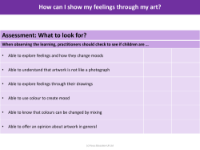Sequence of learning - Art 2 - EYFS

Art and Design Resource Description
In the realm of Expressive Arts and Design for Early Years Foundation Stage (EYFS), children are encouraged to explore their emotions through art. Specifically, three and four-year-olds are expected to learn how to convey different emotions such as happiness, sadness, fear, and more in their drawings and paintings. This involves experimenting with colours and learning about colour mixing, as well as adding details to their artwork to express their feelings more vividly. Practitioners support this by helping children to observe and draw from objects, discussing the features of these objects, and guiding them through the process of colour mixing with questions like "How does blue become green?"
As part of the proposed learning sequence, children are introduced to the work of artists from various times and cultures, enabling them to see the connection between professional artwork and their own creations in terms of details, colour, movement, or line. By the end of nursery, children are expected to have explored how colours can be changed, used lines to enclose spaces, and begun to represent objects within these shapes. They also start to build with blocks and join pieces together to construct and balance. Key vocabulary such as 'happy', 'sad', 'upset', 'afraid', 'scared', and 'laughing' are introduced to help children articulate their emotions in art. The learning sequence includes observing objects closely with a practitioner, drawing inspiration from famous artists, creating their own art with a focus on the desired emotion, and discussing their artwork with others to explain their choice of colours and the emotions they represent.




